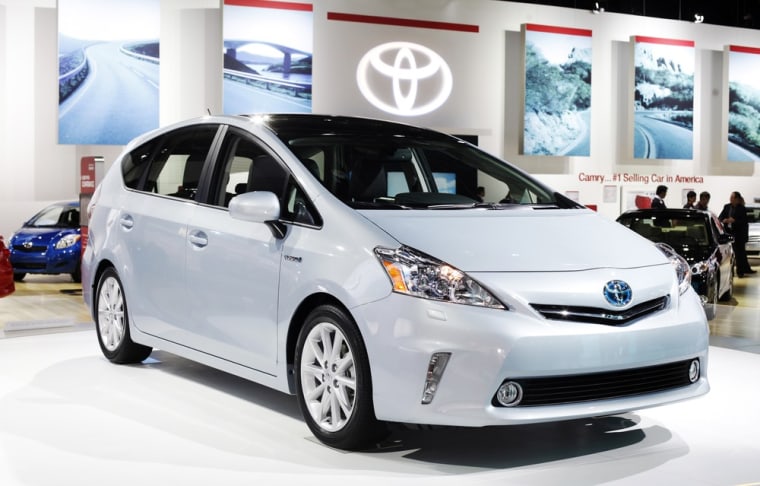Betting that it’s better late than never, Toyota is readying the roll-out of the second hybrid to carry the name Prius out onto the U.S. market. The move is expected to be followed by the introduction of an entire “family” of Prius-badged offerings.
Some skeptics warn that the strategy could wind up confusing consumers. Toyota planners contend that the well-known and widely accepted Prius name will make it easier to sell new hybrid offerings to buyers who have proved surprisingly reluctant to embrace the fuel-saving technology, even while gasoline prices have been nudging record levels.
“We could eventually see a point where [various models dubbed] Prius could lead Toyota sales in the U.S.,” noted Ed LaRoque, the Japanese carmaker’s head of hybrid marketing in the U.S.
Prius already accounts for about half the hybrid-electric vehicles sold in the U.S. As a result of the March disaster in Japan, which seriously hampered automotive production in that market, supplies have dwindled severely.
American auto dealers normally like to have anywhere from 30 to 60 days inventory for cars, but the so-called “days supply” for the original Prius is currently down to around four days, LaRoque warned.
In some ways that could work to Toyota’s advantage when the Prius V comes to market around October, an estimated two months later than originally scheduled.
While sales of other hybrids have actually slipped in recent months, the huge brand recognition and pent-up demand could send buyers scurrying for anything with the Prius badge once production starts picking up.
Initial reviews have generally been favorable for the new model. It adopts a longer, taller and wider wagon-like design that offers notably more interior and cargo space than the Prius “classic,” and a variety of new features. Among them are a highly energy-efficient “green” audio system, a choice of two different navigation system upgrades and radar-guided cruise control.
With the added space and features, buyers will sacrifice some of the original Prius’ fuel economy, which the EPA rates at 51 mpg city and 48 highway for the 2011 model-year. The Prius V, which will launch as a 2012, will be rated at 44 highway, 40 city.
Both models share the same Toyota Hybrid Synergy Drive system, with only modest changes to the gas-electric powertrain on the Prius V to accommodate its added size and weight.
Surprising some, Toyota decided not to adopt a more advanced lithium-ion battery system, though LaRoque echoes the general industry sentiment that “lithium-ion is the future.”
Time-tested nickel-metal hydride batteries will still be Toyota’s fall-back for the third model to enter the new hybrid brand-within-a-brand, the Prius C, due for launch next year. If the V stands for “versatile,” the next model will be the cheap and compact member of the family, a size class smaller and likely thousands of dollars less than the original.
By this time next year Toyota will also be readying to roll out its first plug-in hybrid, a version of the Prius classic that will migrate to lithium power.
That offering is already controversial because it is planned to provide just 13 miles range per charge before switching to its internal combustion engine. Toyota’s arch-rival, General Motors, has given its Chevrolet Volt plug-in a 38 mile range. GM contends that is enough to meet the daily driving needs of about 70 percent of American commuters. It allows them to go weeks — even months — without refueling the gas tank.
The Prius plug-in will cover a much smaller fraction of the population. Considering its already notable mileage, it will likely yield additional fuel savings, at best, of under $1 a day. But it is also expected to carry a price tag many thousands of dollars less than the Volt. And it will be bearing that Prius badge.
But is that a sure bet? Not everyone agrees.
“They could cause confusion with the Prius V and C and other models, much like Lincoln has done by calling its models MKS and MKZ and MKT,” cautioned analyst Aaron Bragman, of consulting firm IHS,
The counter-argument, he quickly added, is that, “This could be the new standard,” if Toyota can “build on the reputation” of the original and convince potential buyers that all the various Prii (the plural of Prius, as suggested by owners) are a cut above the competition.
Like many observers, analysts expect demand for battery-based vehicles to be closely linked to what happens with fuel economy standards here and abroad. A recent J.D. Power & Associates study argued that all forms of electric vehicles — from basic hybrids to plug-ins to battery-electric vehicles — won’t top 7 percent by 2020. Other experts have the number reaching as high as 20 percent and growing even further if the Obama administration moves ahead with a proposed 56 mpg federal mileage standard for 2025.
The real winners, Bragman believes, will be the products that stand out, like the original Prius and subsequent models, which Toyota says will only be hybrid or battery-based.
Apparently, others are buying into that argument. Ford has scrubbed plans to produce a gasoline-powered version of its C-Max “people mover” and will launch it next year solely in electrified form, buyers choosing either a standard hybrid or a plug-in version.
“This is our Prius fighter,” said Ford’s global marketing director Jim Farley, pointing to studies saying the U.S. maker needed a visually distinct model of its own that will, like hybrid, declare itself clean and green whenever it drives by.
